

MedIT. Using Optogenetics and Designer Receptors Exclusively Activated by Designer Drugs (DREADDs) View Article as PDF Summary: Emerging techniques that allow researchers to control the activity of a subset of neurons are revolutionizing our understanding of how the central nervous system works.

Whether to use optogenetics (light) or DREADDs (drugs) as a means to control neuronal activity depends on which question you wish to answer. One of our series of Reports on Progress. Christie D. Fowler, Ph.D., Brian Lee, Ph.D., and Paul J. The ability to manipulate the activity of specific subsets of neurons in the brains of living animals is leading to significant new insights into how the central nervous system works. Brain Machine Interfaces. Polymath Renaissance. Bionica. Biology. Genomics. Complex Systems. TECHNOLOGY. Tech Advances. Body Werx. Robotica. New Ethics. New Print Technica. PrintTech. Wearable Tattoo Electronics Capable of Dissolving in the Human Body.
Wednesday 25 March 2015 14:00 - 15:0014:00 - 15:00ME B1 10 By Dr.

Huanyu Cheng, Northwestern University, Evanston, Illinois, USA Bio : Dr. Huanyu Cheng is currently a Ph.D. candidate working with Prof. Yonggang Huang at Northwestern University. As the Howard Hughes Medical Institute (HHMI) International Student Research Fellow, he also works as a visiting scholar with Prof. Abstract : Recent advances in electronics enable powerful biomedical devices that have greatly reduced therapeutic risks by monitoring vital signals and ... Abstract : Recent advances in electronics enable powerful biomedical devices that have greatly reduced therapeutic risks by monitoring vital signals and providing means of treatment. 0046352aacc7ee6d31000000.pdf. 3D Printing Enables Medical Models with Blood, Guts, & All. 3D printing has been aiding doctors prepare for numerous surgeries by providing highly-detailed, patient specific models to better inform surgeons before entering the operating room.
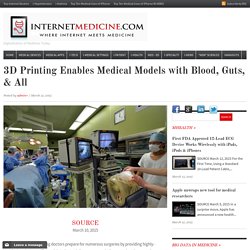
As accurate as these models have been, some even including color-coded regions to illustrate various organs or problem areas, they have yet to fully replicate the texture of real human tissues. Japanese 3D printing firm Fasotec, previously covered on 3DPI and subsequently purchased by Stratasys, is changing that by creating highly realistic surgical models with 3D printing. The Biotexture Wet Model is a patient-specific, soft and wet model that is so realistic that it even oozes fake blood. To produce the wet model, a 3D printed mold is created using a patient’s medical scans. Scalable Neuroscience: or “Why Computers will Never Replace Doctors” (ED NOTE: Warning: Coffee Alert!
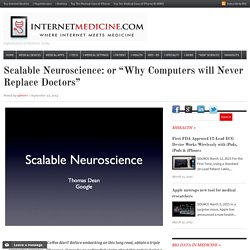
Before embarking on this long read, obtain a triple cappucino expresso. Of course, it may be an outlandish claim about this article being a reason why computers will never replace doctors; but just as outlandish as the claim they will; and perhaps the reader will acceed to this claim because this article is very profound; after all, Tom has a Google email; but, just perusing, one sees glimpses of reasons why not, and until them, let’s put the ball in the believers court to explain “why” and “how” they will.
Then they may get a gmail address, even though Vinod did miss the chance to own that email address for the paltry sum of 1.6 million dollars!) Thomas Dean Google Inc.tld@google.com Helen Wills Neuroscience Institute, Berkeley, April 19, 2013 Abstract Since the beginning of the year, the European Union and United States have separately announced major initiatives in brain science. (April 19, 2013. AutoDesk and Organovo Team Up To Bring Printable Human Organs Closer.
3D printing technology is hot and getting hotter.

Whereas once 3D printers were limited to a few select materials, these days inputs include metal, plastic, glass, wood, and—human cells? Bet you didn’t see that coming. (Actually, if you’re a regular here, you probably did.) Bioprinting firm, Organovo, isn’t anywhere near 3D printing a hand or heart. But a recently announced partnership with 3D modeling software giant Autodesk (maker of AutoCAD) might speed things up a bit. 3D Printed Cast Speeds Bone Recovery Using Ultrasound.
A new prototype brings together 3D printing, room to breathe and ultrasound pulses to create a cast that is not only comfortable and stylish to wear but is expected to speed healing relative to existing options.
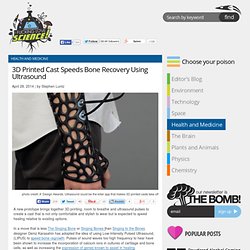
However, despite success in vitro and promising results from clinical studies LIPUS has not been widely adopted, partly because the measured benefit has varied across trials, in some cases appearing too small to justify the effort. Synthetic Biology and metabolic engineering. New Health Concerns. CSN II - Convergent Science Network of Biomimetics and Neurotechnology. NEURObotics...the future of thinking? Blue Brain Project. The Blue Brain Project is an attempt to create a synthetic brain by reverse-engineering the mammalian brain down to the molecular level.
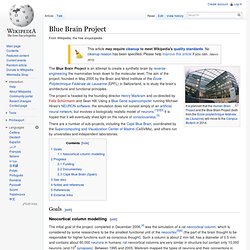
Mind Controlled Bionic Limbs. Paralysed woman's thoughts control robotic arm. 16 December 2012Last updated at 22:14 ET By James Gallagher Health and science reporter, BBC News Unrivalled control of a robotic arm has been achieved using a paralysed woman's thoughts, a US study says.
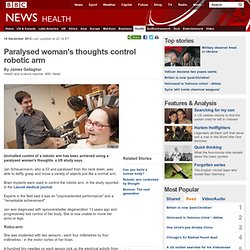
Jan Scheuermann, who is 53 and paralysed from the neck down, was able to deftly grasp and move a variety of objects just like a normal arm. Experts in the field said it was an "unprecedented performance" and a "remarkable achievement". Jan was diagnosed with spinocerebellar degeneration 13 years ago and progressively lost control of her body.
Will we ever… have cyborg brains? After recent triumphs showing that implants could repair lost brain function, Martin W.
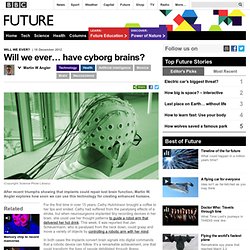
Angler explores how soon we can use this technology for creating enhanced humans. For the first time in over 15 years, Cathy Hutchinson brought a coffee to her lips and smiled. Cathy had suffered from the paralysing effects of a stroke, but when neurosurgeons implanted tiny recording devices in her brain, she could use her thought patterns to guide a robot arm that delivered her hot drink. This week, it was reported that Jan Scheuermann, who is paralysed from the neck down, could grasp and move a variety of objects by controlling a robotic arm with her mind.
In both cases the implants convert brain signals into digital commands that a robotic device can follow. Human organ and tissue transplantation. Xenotransplantation. Xenotransplantation is any procedure that involves the transplantation, implantation or infusion into a human recipient of either (a) live cells, tissues, or organs from a nonhuman animal source, or (b) human body fluids, cells, tissues or organs that have had ex vivo contact with live nonhuman animal cells, tissues or organs.

The development of xenotransplantation is, in part, driven by the fact that the demand for human organs for clinical transplantation far exceeds the supply. Currently ten patients die each day in the United States while on the waiting list to receive lifesaving vital organ transplants. ReWalk™ U.S. - the wearable bionic suit. Odd Gender Differences Found in Walking. If we see a shadowy figure walking down a dark street, our sense of whether it is coming at us or walking away depends on whether we see it as a he or a she, new research finds.
This new result sheds light on the subtle judgments the brain makes when it notices motion. Robohand: How cheap 3D printers built a replacement hand for a five-year old boy. Not too long ago, Liam had no fingers on his right hand. The South African five-year old was born with Amniotic Band Syndrome, which causes amputation of digits before birth. But since November, Liam has been using a series of prosthetic hands designed by two men living on opposite sides of the planet, using open source software and 3D-printing technology. Customised, Fitted, Mechanical Fingers and Hands. Complete set of mechanical anatomically driven fingers by robohand. News! 5/21/2013 Uploaded New Starting point file for Left and Right hands. Files feature numerous changes including:
3D-printed hip implant lets teenager walk again. The 3D-printed implant that has given a once wheelchair-consigned teenager the ability to walk on her own Image Gallery (2 images) Much of the fanfare surrounding 3D printing has centered on its enabling consumers to create objects themselves, potentially circumventing traditional production models. Alongside NBA figurines and 3D printed pizza, however, the technology continues to provide valuable solutions in the field of medicine. Restoring Natural Sensory Feedback in Real-Time Bidirectional Hand Prostheses. Science Translational Medicinestm.sciencemag.org.
Bionic arm restores sense of feeling. 8 October 2014Last updated at 21:56 ET By James Gallagher Health editor, BBC News website. First Bionic Eye Sees Light of Day in U.S. After years of research, the first bionic eye has seen the light of day in the United States, giving hope to the blind around the world. Patients' own heartbeat could work as anti-hacking password for implants. A 'bionic pancreas' might transform how diabetes is managed. Synthetic Biology. Stem cells coaxed into forming partial eyeball - life - 06 April 2011. Mouse stem cells have been coaxed into forming a partial eyeball, and the method may one day lead to retina transplants. Yoshiki Sasai at the RIKEN Center for Developmental Biology in Kobe, Japan, and colleagues encouraged embryonic stem cells to develop into retinal cells, and then grew them alongside a protein matrix to promote the formation of tissue.
Over 12 days, the retinal cells formed a vesicle which subsequently transformed into a cup-like structure. Canadian scientists transform human skin into blood. Dr. Mickie Bhatia (photographed in his McMaster University lab in Hamilton on November 5, 2010) director the of stem cell and cancer research institute at McMaster University in Hamilton and his team of researchers have been able to create blood directly from adult skin cells. Gold nanostars deliver drugs directly to cancer cell nucleus. While effective at killing cancer cells, chemotherapy is currently a shotgun approach that can also harm healthy cells and cause serious side effects in patients. The ability to deliver drugs directly into cancer cells would provide a more targeted approach to more effectively treat the disease with lower doses of drugs and less side effects.
Researchers at Northwestern University are claiming to be the first to develop gold nanostars that provide a much more precise approach by delivering a drug directly to a cancer cell’s nucleus. College student invents gel that halts bleeding. Doctors to exploit mussels' sticking power for surgery. First Tests of Prototype Organic Wires Grown from Seedlings. [1401.4396] Towards plant wires. CRISPR and Other Genome Editing Tools Boost Medical Research and Gene Therapy’s Reach. Biotech research. Biotech.
Bioéthique et débat public : une proposition de loi à revoir. Cyber Robotic.